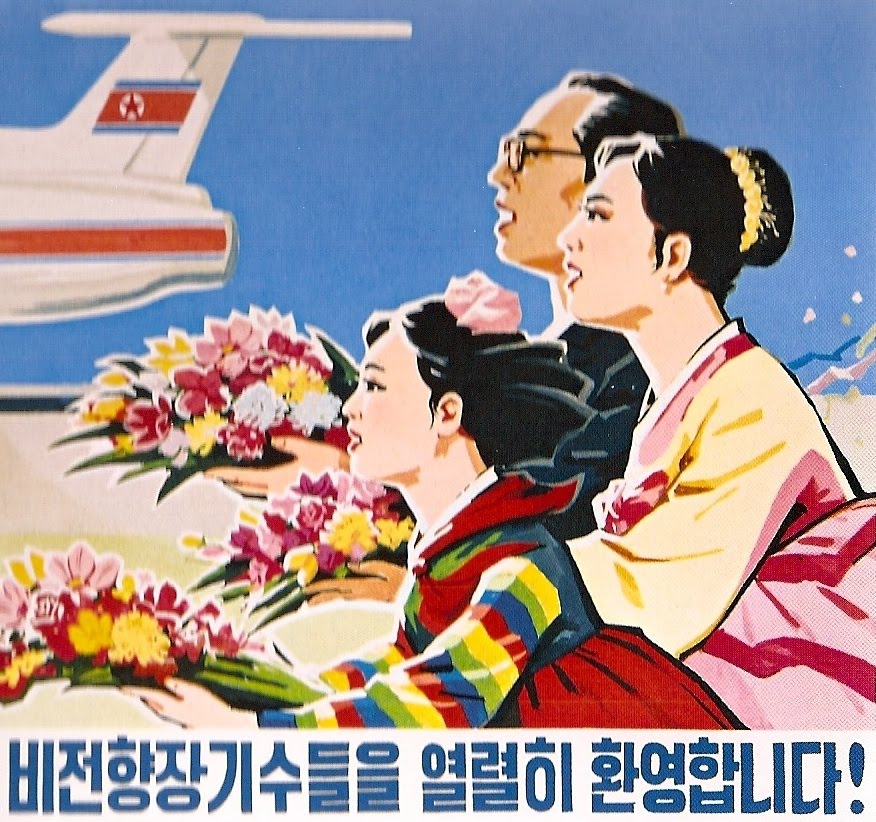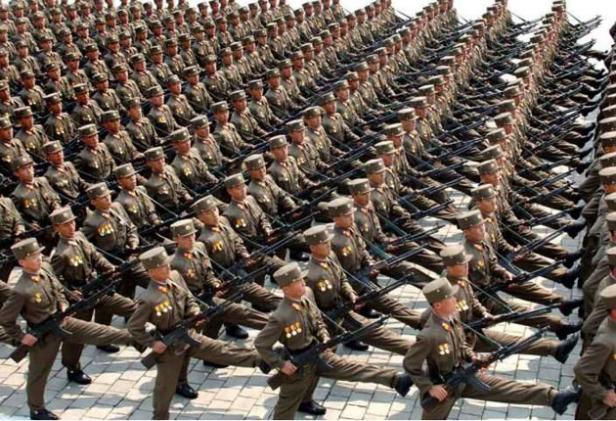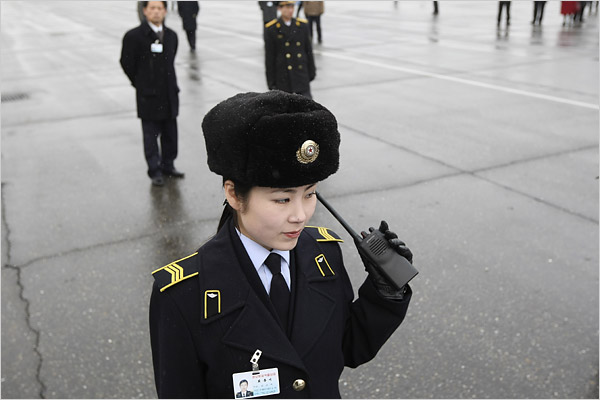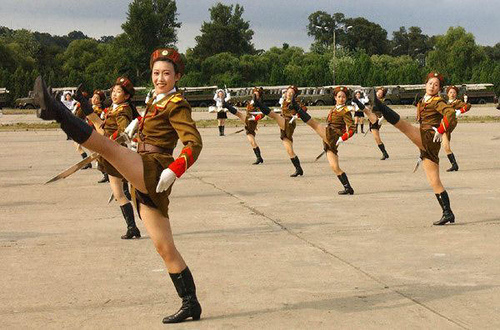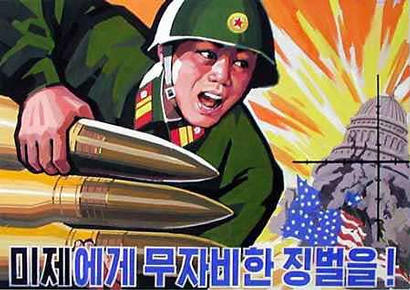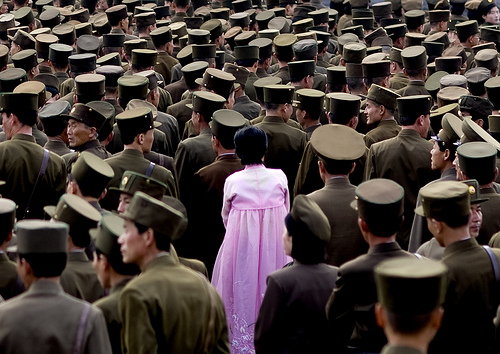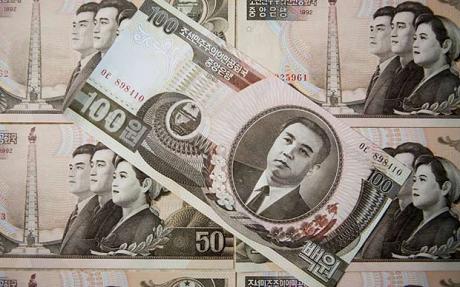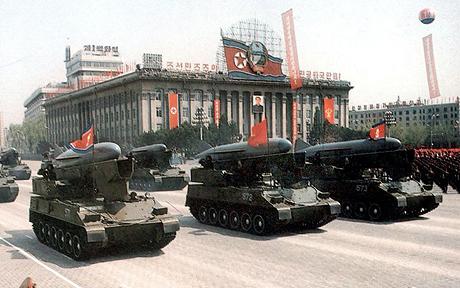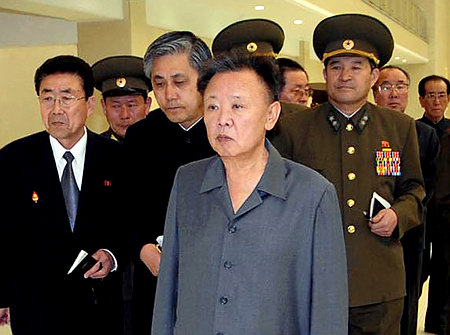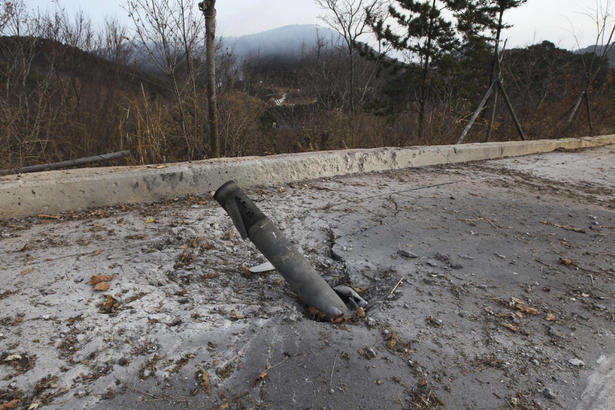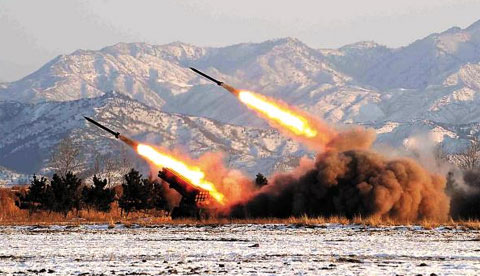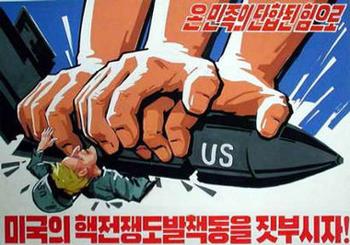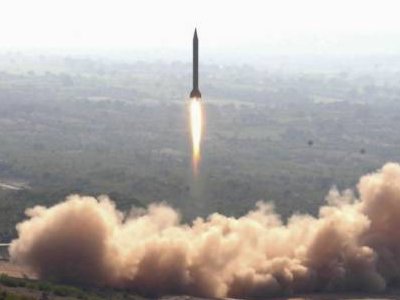|
|
|||||||||||||||||||||||||||||||
|
North Korea: Cold War Relic
The Cold War Relic that America Forgot
By Charles Moffat - May 2011. North Korea (the Democratic People’s Republic of Korea or DPRK) is a country occupying roughly half of the Korean peninsula (the southern half is occupied by South Korea), a country which has been in a state of Cold War (hostile, but avoiding open warfare) since the end of the Korean War. Geography wise North Korea borders with China in its north-west along the Amnok River, Russia in its north-east along the Tumen River, and with South Korea directly south of it. As a heavily populated Asian country North Korea has approx. 24.46 million people (as of July 2011, as estimated by the CIA World Factbook) with a median age of 32.9 due to low standards of health care for the elderly. This lack of good health care coupled with a high infant mortality rate and widespread poverty has resulted in a relatively low population growth rate of 0.538%. The average North Korea has a life expectancy of 68.89. Unlike other Asian countries many North Koreans still live on farms. Only 60% of North Koreans live in cities. But this is only a peek at the reality which is North Korea, a country which still operates under a feudal system of Kings and Princes.
The Hermit Kingdom
Since the end of the Korean War, the North Korean government has isolated their country from the rest of the world. Much of their technology is relics from the 1950s, and while they may pretend to be multicultural with respect to a tiny number of ethnic Chinese and Japanese living within their borders, outsiders have been forbidden and eradicated. The North Koreans believe themselves to be a superior master race (even some South Koreans believe this) deserving of ruling the world. Any claims to racial harmony within North Korea's borders is mere propaganda. Likewise North Korea has virtually eradicated all other religions, and instead have set up government sponsored religious groups to provide the illusion of religious freedom. The government sponsored groups are there both as a propaganda tool and to catch North Koreans who refuse to follow the official government religion.
Irreligion: 64.3%, the vast majority of which follow Juche philosophy and sometimes give lip service to religion.
Korean is the primary language. Knowledge of other languages is strictly monitored, with rare exceptions for diplomats and military personnel. Even athletes traveling overseas are limited when learning other languages, for fear of making it too easy for them to defect when competing overseas. North Korea has an 100% literacy rate, as does South Korea. This is because the Korean Alphabet (Hangeul) is completely phonetic and very easy to learn. It takes just a few days to memorize.
North Korean MilitaryThe North Korean People's Army consists of Ground Forces, Navy, Air Force and civil security forces (effectively the North Korean version of the CIA / FBI). Military service is mandatory at the age of 17.
North Korea doesn't limit itself to male soldiers. As one of the industries that always needs more people, many women are also in the military. Public schools operate a bit like military prep schools, to the extent that every man, woman and child in North Korea has been drilled for war and to hate the United States, South Korea and Japan. Officially North Korea has 9.495 million active, reserve, and paramilitary personnel, but in reality closer to 20 million North Koreans are trained for military service which makes them one of the largest standing armies in the world. It is fortunate that they have a shortage of military equipment like tanks, fighter jets and submarines. The North Korean People's Army is believed to operate the following list of equipment:
The equipment includes a mix of WWII vehicles and weapons, Cold War tech, and rare examples of modern Soviet or Chinese weapons. They've also developed GPS jammers, stealth paint, midget submarines and human torpedoes, chemical and biological weapons. According to North Korean propaganda they claim to have anti-personnel lasers. Military expenditures are approx. 15.8% of the North Korean state budget (2010 figure). The biggest development in the North Korean military is the testing of a nuclear bomb underground in 2009. Their nuclear missile program is the largest feature of the North Korean military and its unknown how many they have built. The CIA have estimated they have enough for at least 9 nuclear missiles by 2010.
North Korean History
For centuries the Korean peninsula was controlled bu the Korean Empire, but it was later annexed by Japan after the Russo-Japanese War of 1905. After the Japanese surrendered to the American in 1945, Korea was split into two countries (North Korea and South Korea) along the 38th parallel, under the control of the Russians and Americans. The United Nations tried to combine the two states into one in 1948 but North Korea refused to participate, believing that participating would put them under American rule. Determined to control all of the peninsula, North Korea invaded the south in 1950, thus kickstarting the Korean War. The Americans and their allies came to South Korea's aid and eventually forced the North Korean military back across the border in 1953 (despite Chinese and Russian help for the North Koreans) and an armistice agreement was made, but no peace treaty was ever signed. More than 2 million civilians and soldiers were killed during the 3 year war. North Korea and South Korea are still technically at war with each other. The border between North and South has since become the Demilitarized Zone (DMZ) which serves as a buffer zone between the two hostile countries. Both North Korea and South Korea were accepted into the United Nations in 1991.
North Korean Capital and GeographyNorth Korea's capital and largest city is Pyongyang. It is also North Korea's cultural and intellectual centre. Of North Korea's 24.46 million in population 3.26 million (13.3%) live in Pyongyang. The next largest city is Hamhung with 769,000 people. Most of North Korea is rolling mountains or farmland, with varying degrees of rough terrain. 80% of North Korea is composed of mountains separated by deep and narrow valleys. Mountains with elevations of 2,000+ metres (6,600 ft) are more treacherous. The highest point is the Baekdu Volcano. The coastal plains are wide in the west. Most North Koreans live in the plains and lowlands.
North Korean Culture
The North Korean Propaganda and Agitation Department controls most of the literature and arts, either to preserve traditional Korean arts or to promote Korean ideals. Outside influence from China, Japan and overseas is admonished. Part of this is a backlash again the Japanese occupation. Under Japanese rule, from 1910 to 1945, Koreans were encouraged to learn and speak Japanese, adopt a Japanese family name and Shinto religion, and were forbidden to write or speak the Korean language in schools, businesses or public places. As a result many North Koreans have a severe hatred of all things Japanese and thus it makes sense that traditional Korean arts now falls into realm of hate propaganda. The "Mass Games / Arirang" is a propaganda event held in Pyongyang, often involving over 100,000 performers, including gymnasts, dancers, martial arts, etc. Anti-west sentiments during the event have been toned down in recent years, but are still present. The purpose of the event is to celebrate the history of North Korea and the Workers' Party Revolution. The North Korean Propaganda and Agitation Department employs over a thousand artists to make artworks using "Socialist Realism", often portraying North Korea as happy and prosperous, which is far from the reality of the poverty stricken nation. Even dress is strictly controlled. Western style suits are forbidden. Men and women wear traditional Korean clothing, except for the military which uses standardized military uniforms.
North Korean Economics
North Korea operates under a government planned and state owned economy. Cuba is the only other country with a similar economic structure. Although its difficult to estimate its believed the North Korean economy is divided up into industry (37%), agriculture (36%), services (27%). An unknown amount of industry and services is actually military oriented. Initially after the Korean War ended in 1953 North Korea did fairly well for itself, trading products with China and Russia, and often getting handouts of cash from both countries. However since the fall of the Berlin Wall and the collapse of communism in Russia, combined with the rise of capitalism in China, trade with North Korea has dwindled to almost nothing. As a result North Korea's resources go largely unused. They have mining resources (iron and coal), but no one to export it to. They have good agriculture, but their population places heavy stress on this and during droughts North Koreans are vulnerable to starvation. The average North Korean makes approx. $1,200 USD per year in wages, making North Korea one of the poorest countries in the world. In order to survive many North Koreans barter their goods or services, relying more on community when times are tough. Beginning in 1997, the USA began shipping food aid to North Korea through the United Nations World Food Programme (WFP) to combat the famine. Shipments in 1999 reached 700,000 tons. Under the Bush Administration, aid was drastically reduced year after year from 350,000 tons in 2001 to 40,000 in 2004. Agricultural production in North Korea had increased from 2.7 million metric tons in 1997 to 4.2 million metric tons in 2004. In recent years North Korea has been adopting some capitalist ideas to improve their economy, including farmers markets.
North Korean Government / Leadership
North Korea is a single-party state led by the Korean Workers' Party (KWP) and under the leadership of their "Great Leader" / President, which is better described as a "hereditary dictatorship". The first president of North Korea was Kim Il-sung, who promoted the Korean ideology of Juche (self reliance) starting in 1955. Following the collapse of the Soviet Union in 1989 and a series of natural disasters, including a famine which killed an estimated 2 million people, Kim Jong-Il adopted a military first policy he called "Songun". In the event of famine / food shortages, the military would get food first while other people starved to death. This was to guarantee that the North Korean military remains strong in the event of an American-led invasion. North Korea defines itself as a communist socialist republic, but its really more of Stalinistic dictatorship / feudal kingdom which uses a cult of personality around its leader and 'princes' to keep the people under control.
Kim Il-sung's son Kim Jong-il took over after the former died and South Korea attempted to woo him with their new "Sunshine Policy" in an attempt to get Kim Jong-il to change North Korea and rejoin the rest of the world, but Kim Jong-il only proved to be utterly corrupt and lazy, having no interest in peace and instead abused his power to write theatre plays, film scripts, and even had his agents kidnap a South Korean actress just so she could act in one of his productions. Kim Jong-il remains the North Korean President to this day, but his health is fading. He had a stroke in 2008 and lost a lot of weight. It is expected he will die before 2016, in which case his youngest son (Kim Jong-un) has been picked to replace him. His youngest son has been chosen because he is the most ruthless and indoctrinated of Kim Jong-il's children, a zealot who absolutely hates the USA. Kim Jong-il's other children are considered too incompetent or not zealous enough.
North Korean Skirmishes & Assassination Attempts
The peace between North Korea and South Korea has been frequently broken by border skirmishes and assassination attempts on South Korean leaders in 1968, 1974 and the Rangoon bombing in 1983. The list of skirmishes below is just a few examples. Between 1953 and 2011 there has been over 40 skirmishes between North and South. North Korea has also tried digging tunnels (successfully several times) under the DMZ. The Axe Murder Incident at Panmunjeom in 1976 was the result of an attempt to clear trees within the DMZ. 2 American soldiers are killed during the incident. In November 1984 a skirmish and firefight ensues when a Russian agent defects across the DMZ. 3 North Koreans and 1 South Korean are killed. 1 American is injured. In 1997 a total of 19 soldiers and 3 North Korean ships crossed the border and fired on South Korean positions before retreating. In June 1999 a series of naval clashes happens between North and South. In 2001 two North Korean navy ships crossed into South Korean territory, was fired upon before withdrawing. In June 2002 four South Korean sailors were killed near the Northern Limit Line, a North Korean ship was sunk during the battle with an unknown number of North Koreans killed. In February 2003 a North Korean fighter jet invaded South Korean territory, was intercepted by 6 South Korean fighters and escorted back north. In March 2003 four North Korean fighters intercepted an USA spy plane over the Sea of Japan. In July 2003 both North and South shoot across the DMZ at each other. Nobody is injured.
In November 2004 a North Korean ship crossed the Northern Limit Line and was escorted back 3 hours later. It claimed to be chasing illegal fishermen. In July 2006 shots are exchanged at South Korean post in Yanggu, Gangwon. In November 2009 multiple ships are involved in the Battle of Daecheong. A North Korean ship suffers serious damage. In March 2010 the South Korean frigate, the Cheonan, is sunk by a North Korean torpedoe. The Bombardment of Yeonpyeong on November 23rd 2010 nearly set off a fresh war between North and South. South Korea was conducting military drills using live ammunition and North Korea warned them to stay away from the border. South Korea ignored this request, conducted the drills, and North Korea ended up firing on the South Korean Navy using artillery. The fight lasted several hours before it finally halted. 2 South Korean civilians and 2 sailors are killed. 16 more people were seriously injured. Approx. 70 South Korean homes were destroyed by artillery barrage. An unknown number of North Koreans are killed or injured. Typically whenever North Korea attacks the South in a skirmish, the South retaliates four fold.
North Korean TerrorismAlthough North Korea has never committed any acts of terrorism, in 2002 United States President George W. Bush labeled North Korea part of an "axis of evil" and an "outpost of tyranny". This made it clear North Korea was in the USA's sights in terms of potential future wars, but was a misnomer because North Korea isn't involved in terrorist activity. Instead North Korea has been focused on its nuclear missile program, which would be an act of war, not terrorism. North Korea has been implicated in a number of bombings, but those were also acts of war just like their frequent incursions across the DMZ and the North Limit Line.
Korean Reunification Talks / Paranoia
For decades South Korea and North Korea have been talking about peaceful reunification, but these talks keep breaking down because of the terms of such agreements. North Korea sees reunification as falling under American control and wants a North Korean style dictatorship to lead the country. South Korea meanwhile balks at the mere idea of any kind of dictatorship, insisting upon democratic rule. The military paranoia of both countries doesn't help either. Both North Korea and South Korea are convinced the other is out to get them, and this is technically true of both countries. Given the opportunity to succeed with minimal losses, they would both gladly invade the other country and take them over. The problem however exists in that both North Korea and South Korea have large standing armies. North Korea has more personnel based on a percentage of its population, but South Korea has a larger population and a lot more military equipment. On an infrastructure level they've both invested in ways to make invasions as difficult as possible (like being able to blow up / blockade bridges on a moment's notice). This level of paranoia throws a whole wrench into the whole idea of reunification. They're so driven by hatred and fear that reunification has become well nigh impossible. (It would be easier to solve the problem of Israel and Palestine.)
North Korean Missile Program
North Korea has a very active aerospace / missile program, designed not to actually go into outerspace but to be used to drop missiles on the USA. Their ultimate goal is to use nuclear missiles to defeat the United States and American allies. In the last decade North Korea has been testing nuclear bombs and long range missiles currently capable of reaching of Hawaii or Alaska from mainland Korea. A long range nuclear missile fired from a Korean ship could reach American cities. As a secretive country, North Korea very rarely lets in foreigners to see their industrial facilities. In 2010 one visitor saw North Korea's uranium enrichment centre and described it as "brand new", "state of the art" and filled with hundreds of centrifuges. This leads to the belief that North Korea isn't just planning to build one nuclear missile, but hundreds. Nuclear missiles has become a central part of North Korea's military policy, as displayed by the many fake missiles they use in parades. Missiles are also a central part of North Korean propaganda.
Lead Up to War
As North Korea's current president is slowly dying there eventually will come a time that control of the country will be handed over to his son and his military advisors. At this critical time its believed that North Korea might decide to begin a campaign of missile deployment in an effort to bring down their hated enemy the United States. Recent skirmishes with South Korea during the last few years leads analysts to believe that North Korea is simply biding their time right now, building up their nuclear missile arsenal so they can bomb the United States in a final confrontation. In response the United States has been running war simulations with their South Korean and Japanese allies, partly to intimidate the North Koreans, partly to prepare themselves for the eventual war. Some analysts believe the United States might even invade North Korea first (or use some kind of event to give the USA an excuse to invade) that way they will catch the North Koreans off guard. Some conspiracy theorists have even speculated that the USA might instigate such a war, shooting down fake North Korean missiles and then using those missiles as an excuse to invade North Korea. Such a plan would not be unheard of, it has been conclusively proven that the Bush Administration planned the attacks of September 11th and brought down both World Trade Centre towers using controlled explosives so it would not be so difficult to create a similar ruse with respect to North Korea. Like September 11th we can expect such a ruse to be televised so that people can see the incoming missiles on TV and then presumably cheer when the missiles are 'shot down' by American anti-ballistic missiles. It should be noted however that there is one fatal flaw in such a conspiracy theory. North Korea has no oil or anything else of value. The whole purpose of September 11th was to allow the USA to invade Iraq, Iran and Afghanistan and build an oil pipeline from Iraq, across Iran and Afghanistan and to the Chinese border in the Wakhjir Pass. Selling that oil to China is a very profitable enterprise because gasoline prices in China are 3 to 4 times higher than they are in the USA. Thus the USA's only reason to attack North Korea would be to remove a nuclear threat. It is far more likely for the USA to attack Iran (which is also a nuclear threat) for the purpose of completing the Trans-Arabia Oil Pipeline.
ConclusionsNorth Korea is a nuclear threat. The longer we wait the more this threat grows. But it will be a difficult task to remove the current regime of hereditary dictators from power and it will only be done through a war, with potentially disastrous consequences. Under President Barack Obama the USA has adopted a wait and see approach called "strategic patience", but this allows North Korea to continue building their nuclear arsenal, which makes nearby neighbours South Korea, Japan and China very nervous.
|
|
||||||||||||||||||||||||||||||
|
Website Design + SEO by designSEO.ca ~ Owned + Edited by Suzanne MacNevin | |||||||||||||||||||||||||||||||

